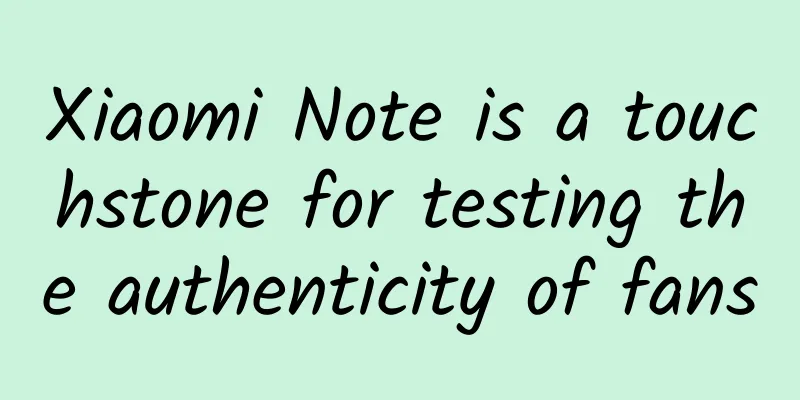Xiaomi Note is a touchstone for testing the authenticity of fans

|
After the release of Xiaomi Note, a great debate in the industry has been triggered about whether Xiaomi's high-end route is feasible. We have seen that the current price range of the top-end version of Xiaomi Note is set at 3,000 yuan. Although this is inconsistent with Xiaomi's long-term cost-effective strategy, Xiaomi co-founder Lin Bin recently pointed out: "In the Xiaomi Note, including workmanship, the screen is thinner, lighter and larger than the iPhone, the camera also has optical image stabilization, and there is also a processor and 4G memory. All of these add up to cost and money." We know that the top-end version of Xiaomi Note uses the Snapdragon 810 processor version, 64GB of body storage space, a 2K-level resolution screen, and supports LTE-Cat9 technology. But we also know that in today's smartphone market, these hardware configurations do not constitute a core advantage. Although Lin Bincheng Xiaomi Note's hardware in terms of configuration and appearance of Xiaomi mobile phones is close to the cost price, in general, the release of the top-end version of Xiaomi Note means that Xiaomi has finally begun to show its sword to the high-end market. The industry has talked enough about the sales forecast and prospects of Xiaomi Note, so I will not repeat them. In my opinion, the sales of Xiaomi Note ultimately depends on whether the Xiaomi fan group is stable. We know that the cost price of Apple mobile phones is only about 1,000 yuan, while the others are valued at brand premiums. Xiaomi co-founder Lin Bin pointed out that the Xiaomi Note is priced at cost, which involves the contradiction of Xiaomi mobile phones themselves. Being a high-end brand, but emphasizing cost-effectiveness, this is not only a lack of confidence in the brand, but also a questioning of the loyalty of Mi fans. Regarding the sales of Xiaomi Note, some people in the industry are optimistic and some are pessimistic. For example, an industry insider pointed out: "Last year, Xiaomi sold 61.12 million mobile phones. Assuming a conversion rate of 15%, that would be 9.168 million phones." But the key point lies in this conversion rate. Is a 15% Xiaomi conversion rate really that simple for Xiaomi fans? We know that Lei Jun is the originator of today's fan economy. Through the operation of social media in recent years, Xiaomi has accumulated a large number of fans on Xiaomi Forum, Xiaomi mobile phones, Xiaomi Weibo, WeChat and other major forums and social media platforms, as well as fans of Lei Jun, Li Wanqiang and Xiaomi employees, and has established a strong fan matrix. Xiaomi's fans are expected to reach tens of millions. We have seen that in 2014, whether it was Mi Fan Festival or Double Eleven, Xiaomi created the myth of selling millions of Xiaomi mobile phones in one day. These fans have supported Xiaomi's brand myth to a certain extent, and are also the capital of Xiaomi's pride. Fan economy is actually a brand capital that calls on consumers' emotions. For example, Xiaomi's fan economy achieves the purpose of product sales by mobilizing consumers' sense of participation and identity. The loyalty of Xiaomi's iron fans comes from several aspects: First, the sense of participation mentioned by Li Wanqiang, Xiaomi fans participate in the optimization and promotion of Xiaomi products such as the MIUI system, and establish feelings with the Xiaomi brand. Second, the cost-effectiveness of Xiaomi's products gives Mi fans a sense of value for money, which brings screams. This cost-effectiveness advantage spreads word of mouth among Xiaomi's fan group, driving Mi fans to participate in the development and weekly iteration of Xiaomi's MIUI system. But fans are collectively unconscious, and loyal fans are like a devout belief in a certain brand. For example, fans of luxury goods such as LV and Hermes are unconsciously blindly following each other, and Apple fans have a religious worship of iPhones. The reason why Apple is invincible in the high-end niche market is that it has been honing its brand premium in the high-end market for a long time, solidifying its high-end brand attribute label and user cognition. However, the difference between Mi fans and Apple fans is that Apple fans are willing to pay for the brand. For example, it is well known in the industry that the cost price of an iPhone is basically around 1,000 yuan, while the others are supported by brand premiums. Mi fans are different. The ultimate goal of Mi fans is to start from self-interest. For example, although Mi fans participate in the iteration and usability of Xiaomi's MIUI system, the product design and development of Xiaomi hardware, the entire process of MIUI system and Xiaomi software upgrades, the purpose of Mi fans is also to promote low-priced Xiaomi mobile phones to have a higher cost-effectiveness and constantly exceed expectations, with the ultimate goal of making profits for themselves. Xiaomi has therefore created a community economy that integrates products and fans. But Xiaomi's risks are also here. Because Apple's high-end brand attributes are driven by the integrated hardware and software ecosystem built by iOS, Apple's hardware process design and bargaining power in the upstream of the industry chain, as well as core technology and ecological integration, which have pushed up Apple's brand premium and have the stability after brand sedimentation. Xiaomi's positioning as "born for fever" is more of a cry and cheer from a group of like-minded low-end and mid-end user groups based on a virtual sentiment of self-identification, which has its own fragility. The fragility of the Xiaomi fan community lies in the fact that Xiaomi fans are happy to enjoy the cost-effectiveness brought by Xiaomi, but are unwilling to pay for the Xiaomi brand and the Internet value-added services built by the Xiaomi ecological chain. We see that Xiaomi currently relies mainly on Xiaomi mobile phone hardware for profit, but it becomes difficult to expect Xiaomi fans to pay for value-added services such as games and memberships within the Xiaomi software ecosystem, so we see that Xiaomi does not talk about profitability, especially profitability of the software ecosystem. In fact, the reason is that it is precisely because Xiaomi focuses on the Diaosi group that its fans cannot help Xiaomi complete the release of the Xiaomi ecological business model and value and promote the Xiaomi brand to move towards the high-end. Xiaomi's transformation to the high-end requires not only a part of the conversion rate of the original Mi fan group, but also inevitably requires a part of the new high-end Xiaomi fans to be pulled in from outside the original Mi fan group, and the original fans inevitably become victims of Xiaomi's brand reshaping. This recognition also starts from the essence of fan economy. Fan groups have a high degree of identity within the group and the brand itself, that is, a sense of belonging to culture and identity caused by the indifference of the group. Apple products focus on the high-end niche market, so Apple fans have a potential unified identity and personalized taste label for members of the group, and reach a consistent sense of identity. Previously, the price of Xiaomi mobile phones basically hovered within the price range of 2,000 yuan. All Mi fan groups are in the same class and have the same identity label of "enthusiasts", so the sense of identity and belonging comes from this. In my previous article "Where are the pain points of the users of the Diaosi economy", I pointed out that in the movie "Fight Club", there is a plot in which the protagonist Jack cures insomnia by participating in the gatherings of the testicular cancer treatment group. In these groups, people with the same disease comfort each other and cry to each other to achieve a kind of recognition and self-healing effect. This is the source of special group identity. That is, common experiences, moods or pursuits can achieve mutual recognition and comfort in a group. Therefore, the problem arises. Xiaomi Note is positioned in the high-end price range of 3,000 yuan, but it artificially breaks the tacit understanding of the unified identity label and self-identity of the Mi fans group with the low-end Xiaomi phones of 1,000 yuan, causing class differentiation within the fan group. Therefore, it may also cause the differentiation of the fan group's culture and identity, and further cause the differentiation and escape of the Xiaomi fan community. Therefore, Xiaomi's future hidden dangers also lie in the Xiaomi fans who have pushed Xiaomi to the altar. Xiaomi mobile phones have long been at the low end, solidifying Xiaomi's cost-effective brand label, deepening the difficulty of Xiaomi's move to the high end, and deepening the fragility of Xiaomi fans, that is, eliminating the unity of the fan group, creating class differences within the fan group, reducing the sense of identity of fans at the same level, and the loyalty of users and fans attracted by low prices is not reliable, making Xiaomi's fan community structure appear fragile. On the other hand, the shortcoming of Xiaomi's business model is that the weaknesses of Xiaomi's hardware core technology and supply chain suppress Xiaomi's brand, but Xiaomi's ecosystem and business model are making great strides. Xiaomi's hardware product line is rapidly and diversified, from Xiaomi routers to Xiaomi bracelets, boxes, TVs, and Xiaomi air purifiers. Therefore, the maintenance of Xiaomi's fan culture in the future will be more difficult. Once the fan culture cannot keep up with the pace of Xiaomi's ecological construction, it may need to make way for the Xiaomi ecosystem. Therefore, the future sales and prospects of Xiaomi Note depend on how Xiaomi convinces its fans and consolidates this group. In addition, Xiaomi has not yet found a better reason to explain why Xiaomi Note is expensive. In fact, the price-performance ratio cannot measure the true fans, and it is impossible to estimate the value and loyalty of Xiaomi fans. It can also be considered that Xiaomi Note is a landmark product that drives the Xiaomi brand to move towards high-end, and it will also be a touchstone to test the authenticity of Xiaomi fans. As a winner of Toutiao's Qingyun Plan and Baijiahao's Bai+ Plan, the 2019 Baidu Digital Author of the Year, the Baijiahao's Most Popular Author in the Technology Field, the 2019 Sogou Technology and Culture Author, and the 2021 Baijiahao Quarterly Influential Creator, he has won many awards, including the 2013 Sohu Best Industry Media Person, the 2015 China New Media Entrepreneurship Competition Beijing Third Place, the 2015 Guangmang Experience Award, the 2015 China New Media Entrepreneurship Competition Finals Third Place, and the 2018 Baidu Dynamic Annual Powerful Celebrity. |
<<: Look, this is the correct way to receive a million-dollar year-end bonus
>>: Gree should seize the opportunity to cooperate with 360
Recommend
After the COVID-19 test turns negative, should we replace toothbrushes, lipsticks and other daily necessities? The December scientific rumor list is released. Let's hear what the experts say.
1. "After the COVID-19 test turns negative, ...
iPhone 4 and first-generation iPad will not be eligible for iOS 8
There are many things that Apple is really good at...
"Wang Baobao"'s new brand marketing methodology
In April 2020, Black Ant Capital led the investme...
World Mosquito Day丨Take it, no thanks! These methods can make mosquitoes "extinct"
Today is a very magical day - " World Mosqui...
"Black Myth: Wukong" is a huge hit. Apart from taking advantage of the popularity, do domestic car manufacturers have any other ideas?
Sales of nearly 10 million in three days! The fil...
You must know these 3 mainstream APP promotion methods!
In recent years, with the development and growth ...
Are all 400 numbers legitimate?
The telephone number starting with 400 is a virtu...
Master the information flow delivery of three major channels: Alibaba, 360, and Kuaishou in one article
“How do I optimize my account?” “How to solve the...
Basic skills of content operation: How to write product soft articles in different ways?
For content platforms that operate products , rec...
After watching ofo’s new ad, I threw away the client’s brief!
Recently, ofo, the shared yellow bike company, re...
The chive dumplings that Gu Ailing ate during the game became popular! Chives: I am best fried with bacon, followed by fried dried tofu
On the morning of February 14, Gu Ailing appeared...
9 methods for selecting topics for short video operations, super comprehensive!
In short video creation, topic selection means th...
Personality changes after a stroke? Don’t panic! This is not pretentiousness, it’s the brain asking for help
After Grandpa Zhang was discharged from the hospi...
91 Ten Articles: Qualcomm's automotive orders exceed US$8 billion, Bosch's annual revenue in China reaches 88.8 billion yuan
1. Qualcomm said that currently more than 150 mil...
Kaola.com Product Analysis Report
Kaola.com focuses on the cross-border e-commerce ...









